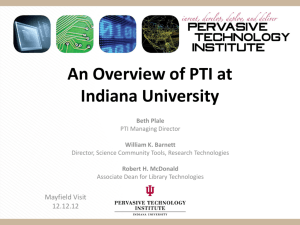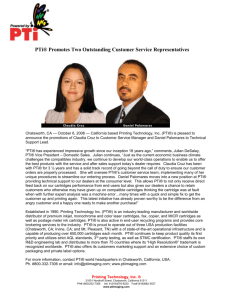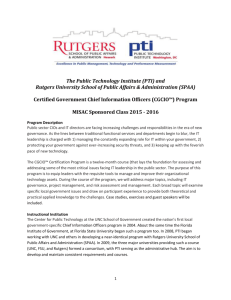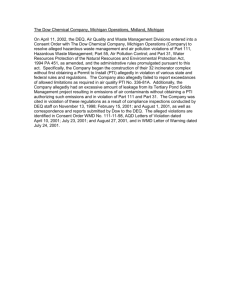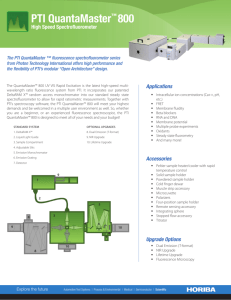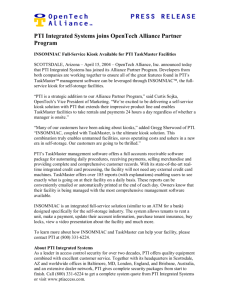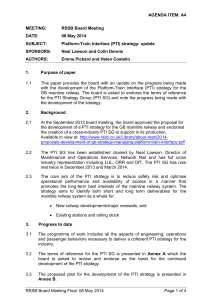AGENDA ITEM: A2 MEETING: RSSB Board Meeting DATE:
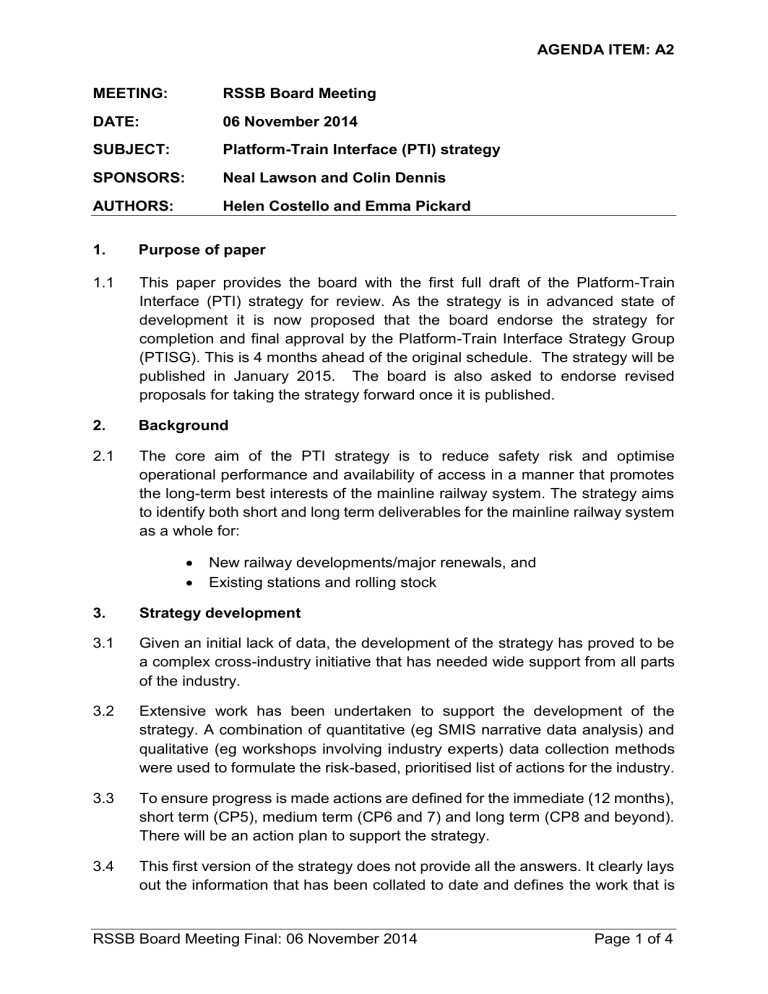
AGENDA ITEM: A2
MEETING:
DATE:
SUBJECT:
SPONSORS:
AUTHORS:
RSSB Board Meeting
06 November 2014
Platform-Train Interface (PTI) strategy
Neal Lawson and Colin Dennis
Helen Costello and Emma Pickard
1. Purpose of paper
1.1 This paper provides the board with the first full draft of the Platform-Train
Interface (PTI) strategy for review. As the strategy is in advanced state of development it is now proposed that the board endorse the strategy for completion and final approval by the Platform-Train Interface Strategy Group
(PTISG). This is 4 months ahead of the original schedule. The strategy will be published in January 2015. The board is also asked to endorse revised proposals for taking the strategy forward once it is published.
2. Background
2.1 The core aim of the PTI strategy is to reduce safety risk and optimise operational performance and availability of access in a manner that promotes the long-term best interests of the mainline railway system. The strategy aims to identify both short and long term deliverables for the mainline railway system as a whole for:
New railway developments/major renewals, and
Existing stations and rolling stock
3. Strategy development
3.1 Given an initial lack of data, the development of the strategy has proved to be a complex cross-industry initiative that has needed wide support from all parts of the industry.
3.2 Extensive work has been undertaken to support the development of the strategy. A combination of quantitative (eg SMIS narrative data analysis) and qualitative (eg workshops involving industry experts) data collection methods were used to formulate the risk-based, prioritised list of actions for the industry.
3.3 To ensure progress is made actions are defined for the immediate (12 months), short term (CP5), medium term (CP6 and 7) and long term (CP8 and beyond).
There will be an action plan to support the strategy.
3.4 This first version of the strategy does not provide all the answers. It clearly lays out the information that has been collated to date and defines the work that is
RSSB Board Meeting Final: 06 November 2014 Page 1 of 4
AGENDA ITEM: A2 required to progress the strategy over the defined time periods. The strategy will be a live document that is revised and updated as research is completed and knowledge is gained.
3.5 It is vital that the industry continues to engage in a collective manner to ensure that the strategy is taken forward and the recommendations implemented, including further funding of associated initiatives.
3.6 The draft strategy is presented in ANNEX B . The proposed style for the presentation of the strategy is presented in the example sheets in ANNEX A .
4. The PTI Strategy – key points and initial actions
4.1 The strategy is taking a new look at the way we manage the PTI. It comprises cross-industry action to:
Improve the understanding the PTI safety risk and the factors that affect performance
Use risk based decision making to optimise safety, capacity, operational performance and cost
Identify and promote good practice
Optimise the platform to train step/gap for use in future vehicle and infrastructure design
Develop and update relevant standards where appropriate
Develop consistent short and long term approaches to managing the PTI across the train operators, Network Rail, ROSCOs, DfT and ORR
Raise awareness through a media campaign
4.2 It is recognised that early action is necessary to get momentum behind the strategy and therefore, as well as the short, medium and long term actions defined in the strategy, the document describes the immediate actions that will take place over the next 12 months. These actions which will include:
1. Promoting the national safety communications campaign – details in section
6
2. Improving data collection and analysis
3. Collecting, disseminating and promoting good practice across the industry
4. Developing and implementing the PTI risk tool
5. Defining and delivering the research necessary to understand the PTI, particularly the analysis of the optimum PTI step/gap which will be critical to defining the future PTI arrangements
6. Undertaking trials
5. DfT policies and strategies relating to the PTI
5.1 As part of the development of the PTI strategy, discussions have been held with the DfT on their policies and strategies that could have an influence on the
RSSB Board Meeting Final: 06 November 2014 Page 2 of 4
AGENDA ITEM: A2 future design and management of the PTI on the GB mainline railway. In relation to new projects and developments DfT are, in accordance with the law, committed to maintaining compliance with the TSIs and the associated UK specific cases as defined in the Railway Group Standards eg. the 915mm high platforms. However DfT noted that where there are cases of dedicated passenger only fleets such as the Crossrail core-section and HS2, consideration has been given to higher platforms that would provide level access that could potentially provide easier boarding, reduced dwell times, improved passenger experience and reduced delays.
5.2 It is noted that for both Crossrail core section and HS2 it is unlikely that conventional freight trains will be run. However there is a need to consider the movement of maintenance trains and machines through these higher platforms together with the implications of stepping distances and access for persons of reduced mobility at platforms with level access and at p latforms that don’t have level access.
5.3 DfT noted that £450m of public money with some match funding has been spent through the Access For All programme providing step free access from street level to station platforms throughout the network and it therefore seems illogical not to significantly improve access onto the trains at stations.
5.4 DfT acknowledge the importance of integrating their thinking in relation to new projects, franchise commitments, rolling stock procurement and infrastructure upgrades and have committed to working with the PTI strategy implementation team to develop an integrated ‘systems approach’ to designing such changes.
In the first instance it has been agreed that a workshop is facilitated by RSSB as soon as possible involving DfT, ORR and the PTI Strategy team to review the current thinking in relation to existing and future projects and procurement strategies to determine how these might influence or be influenced by the emerging PTI strategy such that a joined up and consistent strategy can be developed.
6 Media Campaign
6.1
The media campaign is being led by the PTI programme team, with input from
Network Rail, passenger operators, ATOC and the RSSB communications teams.
6.2
The proposed approach for the media campaign will deliver a general campaign. The overarching theme across the campaign will be ‘Be a safe pair of hands for others’.
6.3 The campaign will be aimed at all users of the railway and will be focused on raising the awareness of the risk at the PTI. We are aiming for a ‘soft’ rollout in
December 2014. It will then be strengthened in mid-January (this is mainly due
RSSB Board Meeting Final: 06 November 2014 Page 3 of 4
AGENDA ITEM: A2 to there being multiple public messages already in existence on the run up to
Christmas) and will include in-station activity.
6.4 In addition, work is underway to prepare a proposal for future media campaigns and targeted messages.
7. Implementing the strategy
7.1 It has been recognised that PTI strategy is of significant importance to the industry and must continue to maintain a high profile. In order to maintain momentum, it is important to reach agreement on how the strategy will be taken forward into implementation. Revised proposals will be presented at the
November board meeting.
8. Recommendations
The original intention was for the board to endorse the strategy in March 2015.
This was accelerated to January 2015. However we now believe that the strategy is in a sufficiently advanced state of development for the board to consider endorsing it now (4 months ahead of the original schedule) with the final changes to be approved by the PTISG before publication.
The RSSB board is asked to:
ENDORSE the national PTI strategy for finalisation by the PTISG and publication by January 2015
ENDORSE the proposals made during the presentation for taking the
strategy forward once it is published
NOTE the media campaign approach for launch in December and the requirement for cross-industry buy-in
RSSB Board Meeting Final: 06 November 2014 Page 4 of 4
ANNEX A
Figure 1 Example PTI Strategy front page
RSSB Board Meeting Final: 06 November 2014 Page 1 of 2
ANNEX A
Figure 2 Example main document page
RSSB Board Meeting Final: 06 November 2014 Page 2 of 2


